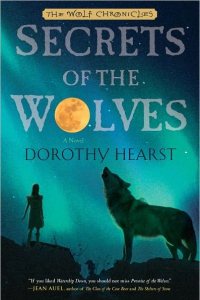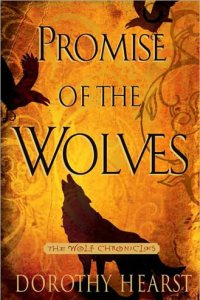Review: 'Promise of the Wolves' and 'Secrets of the Wolves', by Dorothy Hearst

 The Wolf Chronicles trilogy is the story of why wolves and humans can never be friends. Or why they MUST be friends. Actually, I am not sure of anything. If there is one thing at which Hearst excels, it is Being Mysterious.
The Wolf Chronicles trilogy is the story of why wolves and humans can never be friends. Or why they MUST be friends. Actually, I am not sure of anything. If there is one thing at which Hearst excels, it is Being Mysterious.
'Promise of the Wolves'; NYC, Simon & Schuster, June 2008, hardcover $25 (341 pages), paperback $11, Kindle $11.99.
'Secrets of the Wolves'; NYC, Simon & Schuster, August 2011, hardcover $24.00 (371 pages), Kindle $10.99.
Most of Promise of the Wolves is set 14,000 year ago, when both wolves and men lived in primitive, nomadic tribes, except for a Prologue set 40,000 years ago. According to that Prologue, the “promise of the wolf” — “What is the promise of the wolf? Never consort with humans. Never kill a human unprovoked. Never allow a mixed-blood wolf to live.” (blurb) — was already an ancient law among wolves 40,000 years ago. Lydda, a wolf pack member of that time, is drawn to befriend a human, with cryptically untold (until halfway through the novel) but presumably fatal results. Jump to the main story, only 14,000 years ago:
Promise of the Wolves takes us where time is counted in phases of the moon, distance is measured in wolflengths, and direction by the scent of the nearest trail. Years of research into the world of wolves combines with mythical tale-telling to present an epic adventure of wolves, humans, and the remarkable bond we share. (blurb)
The legends say that when the blood of the Wide Valley wolves mingles with the blood of the wolves outside the valley, the wolf who bears that blood will stand forever between two worlds. It is said that such a wolf holds the power to destroy not only her pack, but all of wolfkind. That’s the real reason Ruuqo came to kill my brother, my sisters, and me in the faint light of the early morning four weeks after we were born. (p. 9)
The narrator, and protagonist of the trilogy, is Kaala Smallteeth, a cub born into the Swift River wolf pack of the Wide Valley; a rich land of five packs of wolves, several tribes of men, and untold numbers of other predators and prey animals. Kaala’s mother had mated with an Outsider wolf, which is why Swift River pack leader Ruuqo has come to kill her cubs.
He has just killed all but Kaala when two Greatwolves (dire wolves?) arrive to order him to spare her. Yes, Kaala has Outsider blood. She even bears the “mark of the moon” (a white crescent in her gray fur) on her chest; an especially ominous omen. Ruuqo argues,
'You know the wolves of the Wide Valley must keep their blood pure, or risk the consequences. If we allow her to live, the Ancients could send drought, or a freeze that kills all the prey, or a plague. It’s happened before. The legends tell us so.’” (p. 34)
But the Greatwolves have received a message (from whom?) that Kaala will bring great fortune or great misfortune to all wolves, so they must let her live until they can learn which it is.
The novel is Kaala’s autobiography. The reader learns about life among the wolves in the Swift River pack, and by implication all wolf packs, as she grows from cubhood into a littlewolf, then a yearling youngwolf.
The wolves are distinct personalities: adult leader Ruuqo and his Lifemate Rissa, the tracker Werna and oldwolf Trevigg, yearlings Minn and Yllin, and Rissa’s pups Unnan, Borlla, Reel, and Marra, who would normally be Kaala’s playmates except that Unnan and Borlla are bullies; and almost all of the Swift River wolves take their lead from Ruuqo who distrusts her. Her only real friend is Ázzuen, a pup who seems even more wretched than she is; but he is smart! (Hearst’s well-researched picture of wolf pack life tactfully leaves out why there are no sick or elderly wolves.)
There is also a rich mythology, and an intriguing partnership between wolves and ravens who like to speak in haiku:
Hide now, babywolf.
Maybe raven won’t catch you.
At least not this time. (p. 48)
Kaala meets a young raven, Tlitoo, also with a crescent marking, who claims to have been told by the Bigwolves (Greatwolves) to be her secret guardian. Like Richard Adams with Watership Down, the wolves have a fascinating religion. But not a language, except in annoyingly cryptic bits. The Wide Valley is the home of many prey herds: horses, deer, aurochs, antelope, elkryn. What are elkryn? That is a word in wolf language. Isn’t the whole story presumably in wolf language, conveniently translated into modern English for the reader’s benefit? Never mind; we clearly won’t find out what the elkryn are until Hearst wants us to encounter them. (Clue: they’re extinct today.)
This hinting at mysteries goes on throughout, because Kaala is constantly reminded of her supernatural heritage. Who was her Outsider father, and how did her mother meet him? Who is the lupine ghost who comes to her in dreams?
The dreamwolf laughed. ‘No, little Smallteeth, though I am one of your many mothers from a time longer ago than you can imagine.’ I felt a warmth suffusing me, easing the aches in my body. ‘You are not meant to die today, sisterwolf. You promised your mother you would survive and become pack. You must live and carry on my work. You have much to do.’ (p. 40)
Well, that one is obvious right away; it’s Lydda from 40,000 years ago. Why won’t anyone answer Kaala’s frequent questions?
‘Why not?’ I asked [Ruuqo].
‘Do you question a leaderwolf?’ (p. 196)
This is especially frustrating to Kaala because she can recognize signs that her supernatural destiny may be true. There is the dreamwolf whom only she can see. There are Tlitoo’s hints:
‘There is something the Bigwolves are not telling us, wolflet,’ Tlitoo rasped. His voice was unusually serious. (p. 182)
Whenever she is near a human, her crescent chest marking burns and exerts an irresistible pull on her:
Still I tried to get to the humans, scrabbling my legs under Werrna’s strong body. It hurt when she stopped me. The ache in my chest had lessened as I moved to the humans, and it intensified when I could not go to them. (p. 114)
How can all the signs urge Kaala to go to the humans if this is bad? The pull is finally too great; also, Kaala gets tired of being snubbed.
Tlitoo was waiting for me, and flew above my head as I began the long walk to the human homesite. The humans were why I was different and why Ruuqo disliked me. They held the secret to who I really was, and whether I was bad luck – and to whether I could ever really be a Swift River wolf. I was done with waiting. (p. 197)
Kaala (followed by Ázzuen and Maara) sneaks into a human camp and befriends the girl, TaLi, and her boyfriend, BreLan. What happens in the final 100+ pages of Promise of the Wolves tells the Very Dramatic result of that. But it is not really a conclusion, because this is only the first Book of the trilogy.
Secrets of the Wolves continues Kaala’s story. She, and Ázzuen and Marra, have been driven out of the Wide Valley, but they must return and get the Valley’s wolves and humans to live in friendship.
It had been three moons since we’d last seen our humans […] when the humans and wolves of the Wide Valley had nearly gone to war. […] I had stopped that war, with the help of my packmates, and in doing so had convinced the leader of the Greatwolves to spare us. In exchange I had made a promise: that for one year I would ensure that the wolves and humans of the Wide Valley did not fight. If I succeeded, the Wide Valley wolves and humans would live. If I failed, the Greatwolves would kill us all. (p. 11)
The Greatwolves impose an additional condition.
The council has decreed that for the course of one year, wolves must live with the humans, as members of the same family, as members of the same pack. (p. 36)
The three youngwolves “who at nine and a half moons old were not yet quite considered adults” (p. 13), plus Tlitoo the raven, are eager to be the wolves’ ambassadors, to the outrage of the older wolves who are sure that they are too immature for such an important mission.
‘Pups,’ Ruuqo snarled. ‘We’re supposed to entrust this to pups?’ (p. 37)
But the Greatwolves demand that ALL the Swift River pack go to live with the humans. This worries the youngwolves, who feel sure that the adults are too hidebound to live with humans peaceably.
A more troubling concern is that the wolves must remain equal partners with the humans.
’They [the Greatwolves] said smallwolves are weak [Tlitoo says]. They said wolves will be the humans’ slaves. They said the paradox will make the smallwolves fail and that it would be better to kill all wolves than to let the true nature of wolves be compromised. I heard them. They were loud. (p. 38)
Since the reader knows that prehistoric wolves who became domesticated did in fact evolve into tamed dogs, it seems that Maara and her companions cannot win without failing.
In this middle book, the main question is whether the Wide Valley wolves will come to successfully live with the humans or not. In a subplot, a strange wolf, Demmen, appears who claims to be an envoy from Maara’s exiled mother.
‘For now, your mother is safe, though she is pursued by Greatwolves outside the valley who are determined that the two of you should not be reunited. […] She has asked that you come to her. She said it’s important not only to her but also to the greater good of wolfkind.’ (p. 99)
Can Demmen be trusted? Will extremists among the Greatwolves sabotage the Swift River wolves’ attempt to live with the humans? What is the real reason that ravens live in partnership with wolves?
Secrets of the Wolves introduces dramatic new mysteries. Everyone is keeping secrets from everyone else. Each group has two factions; the Greatwolves, the smallwolves, the humans, and the ravens, all trying to win allies and betray enemies. Some of the mysteries are exasperating because they seem to be unnecessary; just for the sake of being mysterious. But there is plenty here to keep the reader captivated.
Dorothy Hearst says in her blog that she is racing to get The Wolf Chronicles Book 3 written.
About the author
Fred Patten — read stories — contact (login required)a retired former librarian from North Hollywood, California, interested in general anthropomorphics
Comments
Another stupid example of one series of books more expensive on Kindle than as paperback...
You're buying the words, not the paper, so it's more about convenience and release timing. Kindle editions tend to be available as soon as hardback editions are; they are almost instantly readable, and are arguably easier to carry around.
Would the price fall if there were less of a monopoly? Probably, and it likely will in time, but you'll always pay for priority.
I remember reading the first book not long after it came out and being unimpressed with the overall quality of the writing. Unfortunately, I don't really remember much of anything else about the book -- even after reading this review -- so I guess that's something of a statement in itself. *shrug*
Post new comment